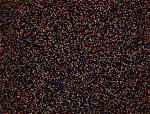Color Detection
Remember that sequencing machines use nucleotides with chemical modifications that produce a certain color signal depending on which nucleotide it is. In this example, Red = A, Green = C, Yellow = G, and Blue = T.

Remember that if there is only one nucleotide that lights up, the color will be too dim to see. To see the color, many copies of the original ssDNA string are made so that they all light up in a bright clump of color.
Spatial Positions
In this example, imagine that there are different strings attached to the surface of the flow cell. Each string has been copied many times, and all the copies of one string are clumped together. You can imagine that all the copies for one string are positioned within a dotted circle.

1. How many strings are on the flow cell's surface in this example?
Now let’s peek at the first two bases of these strings.

2. If you focus on the top-left spatial position (the one with the “CA????.....” string), what complementary base will pair with the first nucleotide, C? If that complementary base attaches to this position, what color will that position light up?

3. If instead of a C in this first position, you have an A, then what color would the spot light up?
4. What color would the spot light up if the first base were G?
5. If the spot lights up red, what base must be in the first position in this spot? Why?
Now you understand something about the information the color shows. But the position is important too. The idea of associating a different string to be sequenced with different spatial locations is called "spatial indexing."

Errors and Noise
Things are not always so clear-cut. As you learned, sometimes there are errors. And sometimes you will see a very small color signal not within a clump. These errors are considered “noise” that can distract you from the real signal.

Parallel Sequencing
Finally, let’s talk about parallel sequencing. This is when all the strings at all the spatial positions are being sequenced at the same time.

6. How many strings have a base that paired with T? Which strings? What base must these strings have in their DNA sequence that caused you to see the blue color?
Putting It All Together
The sequencer works one nucleotide at a time, or one color at a time. So for the example above, we can imagine that it is doing the first base in each of the five strings. Two of them paired with blue T. The sequencer captures a picture of the position of all the spots that turned blue.
Now the blue Ts are removed and the flow cell is exposed to yellow Gs. If any of the three remaining strings have a C as their first base, they will light up yellow and the sequencer will take a photo. Then the yellow is removed and the green Cs are added to the flow cell, and so on.
In other words, to get the first position of all the strings on the flow cell, you must expose the cell to each colored nucleotide, one at a time, taking a picture of your results after each color. To get the second base in each string, you repeat this process with the four colored nucleotides.
7. How many times do you need to go through the cycle of applying each colored nucleotide if your strings are 150 bases long?


 Discovering the Genome
Discovering the Genome